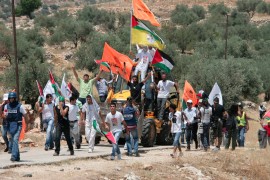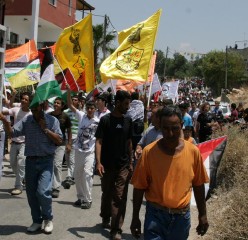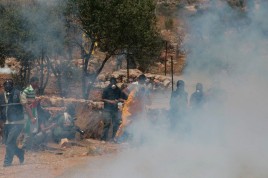Dave Reese/Special to the Inter Lake,
September 29, 2011
(Note: Although the editors of the Daily Interlake (a Kalispell daily) requested this article,
they rejected it after they had read it. sn)
Some of his scars look fresh, as if the injury might have been inflicted a week ago. Maybe a month.
One of the other scars from the bullet wounds has grown slick and taut,
running in a long crevasse down Rani Burnat’s neck, across his
abdomen and out his waist.
It was 10 years ago that Burnat, 30, was shot 10 times during a parade
in Ramallah to protest Israeli prime minister Ariel Sharon’s
appearance at the Al Aqsa mosque.
As the parade approached a group of soldiers, the bullets began
raining. “They wounded and killed us, protestors whose only
ammunition was their will,” Burnat said.
Burnat survived the shooting, but was left paralyzed from the waist
down. He lives in his hometown of Bil’in, a small village in
southern Palestine, with his wife and three young daughters (triplets).
He is confined to a motorized wheelchair that allows him to roam freely
about the village, usually with his camera and one of his daughters on
his lap. He’s close to the action, still. People come from around
the world, and the West Bank of Palestine, to participate in the weekly
demonstrations against the Israeli occupation of Palestinian
territories.
It’s on a Saturday when I arrive in Bil’in. After an
evening meal with a local family, I walk from the village down a narrow
road out of town, among farmers tending their olive trees, and boys
playing soccer in the streets. Coming out of this pastoral landscape in
an ancient country, I’m suddenly thrust upon the view of Israeli
soldiers carrying automatic weapons behind a barbed wire fence.
The soldiers stir, and more troops are called in. They arrive quickly
in small green jeeps. I realize that from a distance my camera tripod
slung over my shoulder might look like a rifle. Within minutes
about 20 Israeli soldiers have arrived and move quickly about,
preparing for something to happen. Nothing really does. We watch each
other through the fence and above us, a tall tower with cameras watches
our every move.
I could see why the soldiers might be on edge. The day before, hundreds
of people made the weekly walk from the local mosque after Friday
prayers, to stand with the green, black and red colors of the Palestine
flags, and make peace signs with their fingers toward the soldiers.
On this day, the pungent smell of tear gas lingers in the air. Even a
day after the canisters have been spent, the acrid smell bites at my
nostrils. Small black rings of burned out fires dot the brush and grass
where phosphorus canisters were hurled the day before by Israeli
soldiers. Charcoal streaks run up the trunks of the olive trees, some
of which are thousands of years old and have fed families for
generations.
In his wheelchair Burnat accompanies the weekly demonstrations and each
week the result is mostly the same: tear gas lobbed over the fence,
local residents and international aid workers scurrying for cover,
using branches to beat out the fires that pop up in the underbrush.
The weekly demonstrations in Bil’in are a symbol of the ongoing struggle between Palestine and Israel.
For Burnat, who has been wounded numerous times from rubber bullets and
shock grenades, the weekly demonstrations are a chance for him to speak
out against injustice. “I live in a wheelchair, but it does not
limit me from saying no to the occupation, saying no to oppression, and
saying no to injustice, slavery and bloodshed,” he said. “I
continue to say yes to peace, freedom, liberty and independence. We
protest against the racist wall, land confiscation and settlement
construction. I am in front of the parade with my camera. These photos
are a tool in my struggle against injustice and those who responsible
for it.”
Examples:



This struggle has been going on for some 65 years, after the United
Nations created the State of Israel. Since then, hundreds of thousands
of Palestinians have been forced to leave the country, as Israeli
occupation has continued to extend much farther into Palestine than was
originally agreed upon in the 1948 declaration of the State of Israel
following World War II.
I spent two weeks in Palestine and Israel this summer, learning about
the cultures, people and history of this dramatic place for a
documentary film. This was my second opportunity to travel with Sam
Neff and Ruth Neff of Whitefish, who organized the trip with Neighbors
East and West, a peace outreach group. We’d been to the Islamic
Republic of Iran in 2008, a unique and interesting culture — but
this journey had a greater sense of urgency and drama.
We witnessed how an oppressed and terrified people try to react to the
Israeli occupation with nonviolence. For the most part, the
Palestinians I interviewed harbor no ill will against the Israelis;
they just want their land back. When the British left Palestine in the
1940s, leaving the country open for exploitation, the United Nations
cleaved the country in half for Palestine and the new Israel, dividing
it neatly by the “Green Line” down the middle. Since then,
the Israelis have encroached farther and farther into Palestinian
territory, occupying (some say stealing) more and more land.
In 2000, as a result of continued violence between the two
factions, Israel began installing a huge barricade between itself and
the West Bank of Palestine. This formidable wall of concrete, some 50
feet high, snakes circuitously through land that Israel has claimed for
itself, dividing families and cultures that were once neighborhoods.
Nearly 200 miles long, the wall is the Israelis’ way of
controlling who comes and goes into its country. In early morning in
Bethlehem, after arriving in Israel at Tel Aviv airport, I watch about
100 men being herded like cattle through a long narrow chute. They
marched through a door in the wall, not toward freedom but toward work.
With Israel controlling what comes in and out of Palestine, economic
conditions have deteriorated to the point where many men must travel
each day, through the wall, to work for cheap wages in Israel. At dark,
they must return home, through the wall. It is said that the two top
countries for Israeli exports are the West Bank and Gaza.
When it comes to cheap labor, Palestine is to Israel what Mexico is to the United States.
One young Palestinian boy told me the wall was built through his
family’s yard and it now separates him from his grandparents.
Nonplussed, he painted a window on the wall so that he can imagine
seeing his grandparents through it.
The wall starkly demarcates economic and social conditions. On one side
you see trash heaped in the streets, a rotting stench wafting on the
heat of the afternoon; on the other side you see green lawns, swimming
pools and soccer pitches.
In Hebron, one of the oldest cities in the world, the wall has divided
centuries-old neighborhoods. Children on their way to school must pass
through Israeli checkpoints, often being detained as their Spiderman
backpacks are searched for bombs. When I was filming in Hebron, I
captured images of young Jewish soldiers herding children back on to
their side of the fence by the muzzles of their automatic weapons.
On my journey I found that the historical narrative of the cradle of
civilization continually collided with the ongoing conflict between
Israel and Palestine. While swimming in the Sea of Galilee (which is
actually a lake about half the size of Flathead Lake) I heard what I
thought was thunder. This being a cloudless day, that thought made no
sense and I soon discovered that what I was hearing was practice
bombing runs in the nearby Golan Heights.
This contrast haunted me throughout my visit. When I stood in an
ancient amphitheater near the village of Jenin military jets roared low
overheard in an Israeli show of force.
WHEN PALESTINIANS have nowhere else to go, they likely emigrate to
nearby Jordan, Syria or Lebanon, or wind up in a refugee camp.
These camps are not tent cities as one might imagine, but sprawling
city blocks of tall concrete structures run by the United Nations. In
Deheishe, nearly 30,000 people live in a concrete maze of buildings
about the size of downtown Whitefish.
Another refugee camp is in Jenin, site of the 2000 intifada or
“uprising” that resulted from peace negotiations breaking
down between Palestine and Israel.
Just outside the Jenin refugee camp, a stucco wall on a side street is
pockmarked with bullet holes. The bullet holes are next to the entrance
of the Freedom Theatre, a performing arts organization that was created
in 2006 to help children of the refugee neighborhood process their
anger and frustration in the aftermath of the Al Aqsa Intifada.
When I visited the Freedom Theatre in June, the actors and organizers were dealing with much more recent anger and frustration.
Like the bullet wounds on Rani Burnat’s back, the scars were
still fresh for “Rawand,” manager of the Freedom Theatre.
Their director had been killed two months earlier outside the theatre in April.
It was just April 4 when Rawand, several actors and director Juliano
Mer Khamis were rehearsing a play. With his 10-month old baby boy
fussing, Mer Khamis, 52, decided to take his baby home to rest. Within
a few minutes Rawand and the others heard shooting. She told me they
ran outside and found Khamis dead in the street, his arms wrapped
around his baby. He had been murdered in his car as he was leaving the
theatre. His babysitter had been shot also, non-fatally.
I was fortunate to be in Jenin for the first performance the Freedom
Theatre had given since Mer Khamis’ death. The short play, called
“What Else?” examined the lure of Israeli society and the
clash among their own Palestinians. It was a raw, visceral performance,
made stronger by knowing that after the play most of the young men in
the play would be returning home, across the street, to the refugee
camp.
The performance had helped the theatre company process their grief and anger over Mer Khamis’ death, Rawand said.
“When our friends come to see this play, they support us,”
she said. “That means that he is still alive. We don’t know
who killed Juliano, but this shows the killer, ‘You killed
Juliano but you can’t kill his thinking, his ideas.’”
For Rawand, Mer Khamis was her mentor, teacher, brother and father.
“When he died, I cried for two months,” she said. “I
was completely crazy. I lost everything. But I started to wake up.
Everyone dies and we have to continue, if we love him.”
As she was explaining the positive impact Mer Khamis had on the young
men of the Jenin refugee camp, a prop falls offstage. Rawand
nearly jumps out of her seat in fright at the noise. “I thought
someone was shooting,” she said.
The Palestine/Israeli conflict draws thousands of people from around
the world to participate in peace movements or non-governmental
organizations, such as Defense for Children International, an
organization that monitors Palestinian children in Israeli jails.
Adam Schiller, of the Gush Shalom peace movement, is one of the many
international peace activists in Israel. He has witnessed the struggle
between Jews and Arabs since the early 1990s.
“It’s like being a long distance runner,” he said in
an interview in Tel Aviv. “You always have to try to find the
positive aspects in a situation, which is not always easy.
“But the very worst thing you can do as a peace activist is to be
like a flower child of the 1960s. Everybody loves you … but
nobody takes you seriously.”
“You have to think in very concrete political details. You have
to assume that we are not going to be the people who ultimately achieve
peace,” he said. “We have to assume that the agreement we
propose would have to be done by the politicians and it would get them
re-elected.”
The struggle for a solution to peace between Palestine and Israel
continues in the United Nations this week, as Palestinian president
Mahmoud Abbas seeks to gain official recognition of the state of
Palestine as a member of the United Nations. By doing this, Abbas hopes
to be able to pursue criminal charges against Israel for the illegal
occupation of Palestine territories in the last 65 years. If it fails,
many think the move could provoke further protests in the “Arab
Spring.”
From his front porch in Bil’in, Rani Burnat can see illegal
Israeli settlements across a wide, dry valley. The wall and some 65
years of conflict separate the settlement from his family. He harbors
no ill-will toward the people who have moved into the settlements, many
of which are populated with people from around the world who have come
home to Israel.
“I’m angry at the (Israeli) government’s policy, not
the people,” Burnat said. “For the people, we all aspire to
live in freedom and peace. Together we all continue to struggle to
secure ourselves and our children lives full of love, peace, and
safety.”


